†Corresponding author. E-mail: tkliuhs@163.com
*Project supported by the National Basic Research Program of China (Grant No. 2012CB922103), the National Natural Science Foundation of China (Grant Nos. 11175113, 11274104, and 11404108), and the Natural Science Foundation of Hubei Province, China (Grant No. 2011CDA021).
We find the time evolution law of a negative binomial optical field in a diffusion channel. We reveal that by adjusting the diffusion parameter, the photon number can be controlled. Therefore, the diffusion process can be considered a quantum controlling scheme through photon addition.
In a recent paper, [1] we have pointed out that an initial number state | l⟩ ⟨ l| undergoing through a diffusion channel, described by the master equation[2, 3]

would become a new photon optical field, named the Laguerre-polynomial-weighted chaotic state, whose density operator is

Here ∷ is the normal ordering symbol, 
To go a step further, we derive the evolution law of a negative binomial state (NBS) in a diffusion channel in this paper. Physically, when an atom absorbs some photons from a thermo light beam, the corresponding photon field will be in a negative binomial state. We are thus challenged by the questions: how an initial NBS evolves in a diffusion channel, what is the final state, and what is the photon number distribution in the final state. To the best of our knowledge, such questions have not been touched on in the literature before.
Our paper is arranged as follows. In Section 2, we convert the density operator of NBS into the normally ordered form. In Section 3, based on the Kraus-operator solution corresponding to the diffusion channel, we find the evolution law of NBS in the diffusion channel. Then in Section 4, we calculate the photon number distribution in the final state.
Corresponding to the negative-binomial formula

there exists a negative-binomial state of quantum optical field[4]

where 

Using [a, a† ] = 1 and 

where ρ c denotes a chaotic field

Equation (6) tells us that when some photons are detected for a chaotic state, e.g., after detecting several photons, the chaotic light field exhibits a negative-binomial distribution. One can further show TrΣ c = 1, and

is the mean number of photons in the chaotic light field. According to the Bose– Einstein distribution, 

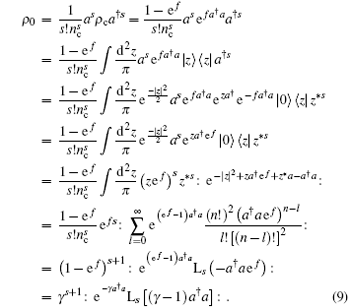
where we have used 

Equation (9) is quite different from Eq. (1), so they represent different optical fields.
In Ref. [9], by using the entangled state representation and the IWOP technique, we have derived the infinite sum form of ρ (t)
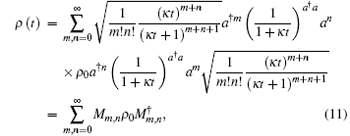
where

satisfies 
Now we examine the time evolution of the negative binomial optical field in a diffusion channel. Substituting 
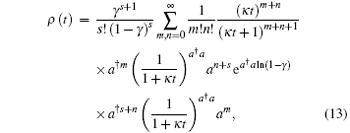
in which we first consider the summation over n. Using

we have

From Eq. (9), we have

It follows

Substituting Eq. (17) into Eq. (15) and multiplying 
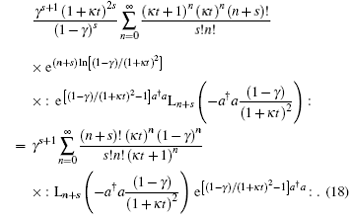
Then using the new generating function formula about the Laguerre polynomials[10]

we obtain

For ρ (t) in Eq. (13), we need to perform the summation over m. Using the summation technique within normal ordering, we have

where


Comparing ρ (t) in Eq. (21) with ρ 0 in Eq. (9), we can see the big difference. Now we must check if Trρ (t) = 1. In fact, using the coherent state’ s completeness relation 

we do have

Now we evaluate the photon number average in the final state. Using Eqs. (10) and (21)– (24), we have
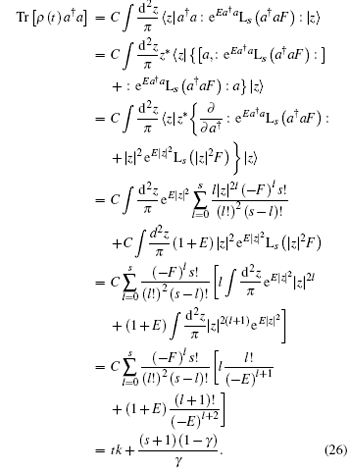
Comparing with Eq. (5), we find that after passing through a diffusion channel, the photon average of NBS varies from (s + 1) (1 − γ )/ γ to tk + (s + 1) (1 − γ )/ γ ,

This result is encouraging, since by adjusting the diffusion parameter κ , we can control the photon number. When κ is small, it slightly increases by an amount of κ t. Therefore, the diffusion process of NBS can be considered as a quantum controlling scheme through photon addition.
| 1 |
|
| 2 |
|
| 3 |
|
| 4 |
|
| 5 |
|
| 6 |
|
| 7 |
|
| 8 |
|
| 9 |
|
| 10 |
|


